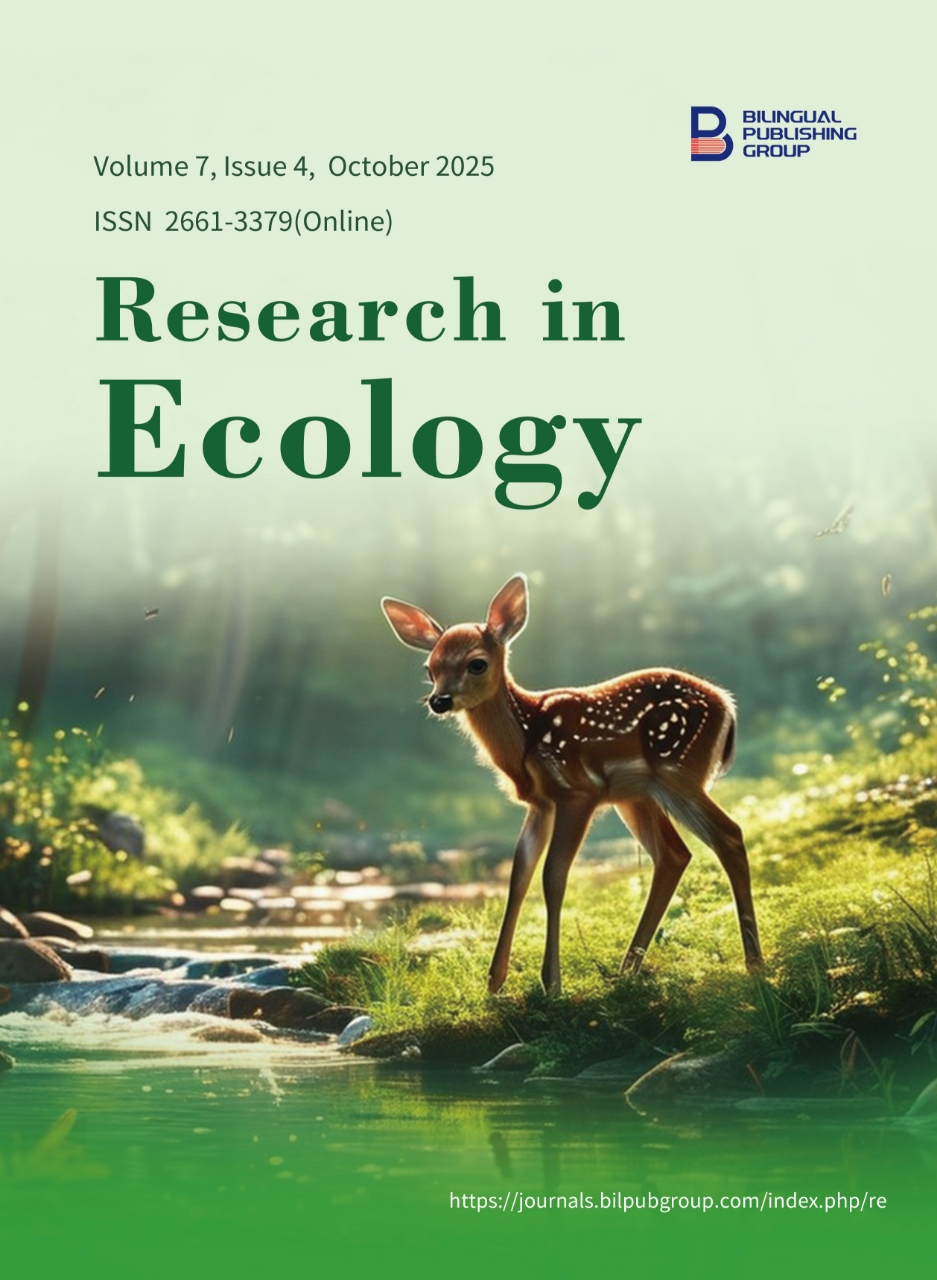
Ecological Implications of Foliar Zinc and Iron Application on Growth Dynamics and Sustainable Productivity of Chickpea (Cicer arietinum L.)
DOI:
https://doi.org/10.30564/re.v7i4.9642Abstract
The physico-chemical analysis of agricultural soil revealed a textured sandy loam at the surface (0–15 cm), with low organic carbon content (0.42%) and moderate levels of nitrogen (157 kg/ha), phosphorus (15.5 kg/ha), and potassium (112.6 kg/ha), under neutral pH conditions (pH 7.4). The chickpea variety PG-186 was used to evaluate the impact of nutrient treatments on plant performance and agroecological outcomes. Experimental findings demonstrated a significant influence of various treatments on the growth, yield, and economic returns of chickpea cultivation. The treatment comprising 100% Recommended Dose of Fertilizers (RDF) along with foliar application of 0.6% ZnSO₄ and 0.9% FeSO₄ at pre-flowering and pod development stages (T8) resulted in the maximum plant height (15.5 cm, 33.7 cm, 45.0 cm), dry matter accumulation (27.5 g, 245.2 g, 1006.7 g/m²), and number of branches per plant (3.47, 5.00, and 8.63) at 45, 75, and 105 Days After Sowing (DAS), respectively. This treatment also resulted in the highest grain yield (21.00 q/ha) and stover yield (38.67 q/ha), along with a maximum net return of ₹95,392/ha and a benefit-to-cost ratio of 2.32. From an ecological standpoint, this study highlights the vital role of balanced and targeted nutrient management in enhancing agroecosystem productivity while maintaining ecological balance. The integration of micronutrient foliar sprays not only boosts nutrient uptake efficiency and plant health but also reduces dependency on excessive chemical fertilizers, thereby mitigating potential negative impacts on soil ecology. Overall, the findings underscore the ecological importance of optimizing nutrient inputs in legume-based cropping systems to foster sustainable agricultural practices that align with ecological resilience, soil health preservation, and environmental stewardship.
References
[1] Yadav, A., Yadav, I.S., Yadav, C.K., 2014. Stability analysis of yield and related traits in chickpea (Cicer arietinum L.). Legume Research - An International Journal. 37(6), 641–645. DOI: https://doi.org/10.5958/0976-0571.2014.00689.4
[2] Diapari, M., Sindhu, A., Bett, K., et al., 2014. Genetic diversity and association mapping of iron and zinc concentrations in chickpea (Cicer arietinum L.). Genome. 57(8), 459–468. DOI: https://doi.org/10.1139/gen-2014-0108
[3] Kaur, R., Prasad, K., 2021. Technological, processing and nutritional aspects of chickpea (Cicer arietinum)—A review. Trends in Food Science and Technology. 109, 448–463. DOI: https://doi.org/10.1016/j.tifs.2021.01.044
[4] Jukanti, A.K., Gaur, P.M., Gowda, C.L.L., et al., 2012. Nutritional quality and health benefits of chickpea (Cicer arietinum L.): A review. British Journal of Nutrition. 108(S1), S11–S26. DOI: https://doi.org/10.1017/S0007114512000797
[5] Gangola, S., Joshi, S., Kumar, S., et al., 2021. Differential proteomic analysis under pesticides stress and normal conditions in Bacillus cereus 2D. PLOS ONE. 16(8), e0253106. DOI: https://doi.org/10.1371/journal.pone.0253106
[6] Ahlawat, I.P.S., Gangaiah, B., Zahid, M.A., 2007. Nutrient management in chickpea. In: Yadav, S.S., Redden, R.J., Chen, W., Sharma, B. (eds.). Chickpea Breeding and Management, 1st ed. CABI: Wallingford, UK. pp. 213–232. DOI: https://doi.org/10.1079/9781845932138.010
[7] Singh, R., Sharma, P., Varshney, R.K., et al., 2008. Chickpea improvement: Role of wild species and genetic markers. Biotechnology and Genetic Engineering Reviews. 25(1), 267–314. DOI: https://doi.org/10.5661/bger-25-267
[8] Gangola, S., Sharma, A., Joshi, S., et al., 2022. Novel mechanism and degradation kinetics of pesticides mixture using Bacillus sp. Strain 3C in contaminated sites. Pesticide Biochemistry and Physiology. 181, 104996. DOI: https://doi.org/10.1016/j.pestbp.2021.104996
[9] Gangola, S., Sharma, A., Bhatt, P., et al., 2018. Presence of esterase and laccase in Bacillus subtilis facilitates biodegradation and detoxification of cypermethrin. Scientific Reports. 8(1), 12755. DOI: https://doi.org/10.1038/s41598-018-31082-5
[10] Alloway, B.J., 2009. Soil factors associated with zinc deficiency in crops and humans. Environmental Geochemistry and Health. 31(5), 537–548. DOI: https://doi.org/10.1007/s10653-009-9255-4
[11] Gangola, S., Joshi, S., Bhandari, G., et al., 2023. Omics approaches to pesticide biodegradation for sustainable environment. In: Advanced Microbial Techniques in Agriculture, Environment, and Health Management. Elsevier: Amsterdam, Netherlands. pp. 191–203. DOI: https://doi.org/10.1016/B978-0-323-91643-1.00010-7
[12] Shivay, Y.S., Prasad, R., Pal, M., 2001. Effect of variety and zinc application on yield, profitability, protein content and zinc and nitrogen uptake by chickpea (Cicer arietinum). Indian Journal of Agronomy. 59(2), 317–321. DOI: https://doi.org/10.59797/ija.v59i2.4558
[13] Rana, A., Joshi, M., Prasanna, R., et al., 2012. Biofortification of wheat through inoculation of plant growth promoting rhizobacteria and cyanobacteria. European Journal of Soil Biology. 50, 118–126. DOI: https://doi.org/10.1016/j.ejsobi.2012.01.005
[14] Bouis, H.E., Hotz, C., McClafferty, B., et al., 2011. Biofortification: A new tool to reduce micronutrient malnutrition. Food and Nutrition Bulletin. 32(1_suppl1), S31–S40. DOI: https://doi.org/10.1177/15648265110321S105
[15] Gangola, S., Bhatt, P., Joshi, S., et al., 2022. Isolation, enrichment, and characterization of fungi for the degradation of organic contaminants. In: Udayanga, D., Bhatt, P., Manamgoda, D., Saez, J.M. (eds.). Mycoremediation Protocols. Springer US: New York, NY, USA. pp. 1–11. DOI: https://doi.org/10.1007/978-1-0716-2006-9_1
[16] Valenciano, J., Boto, J., Marcelo, V., 2011. Chickpea (Cicer arietinum L.) response to zinc, boron and molybdenum application under field conditions. New Zealand Journal of Crop and Horticultural Science. 39(4), 217–229. DOI: https://doi.org/10.1080/01140671.2011.577079
[17] Upadhyay, H., Gangola, S., Sharma, A., et al., 2021. Contribution of zinc solubilizing bacterial isolates on enhanced zinc uptake and growth promotion of maize (Zea mays L.). Folia Microbiologica. 66(4), 543–553. DOI: https://doi.org/10.1007/s12223-021-00863-3
[18] Ram, S., Malik, V.K., Gupta, V., et al., 2024. Impact of foliar application of iron and zinc fertilizers on grain iron, zinc, and protein contents in bread wheat (Triticum aestivum L.). Frontiers in Nutrition. 11, 1378937. DOI: https://doi.org/10.3389/fnut.2024.1378937
[19] Zarea, M., 2025. Effect of foliar application of Azospirillum brasilense and zinc sulfate on the grain-filling process of rainfed wheat. Iran Agricultural Research. 43(2), 1–9. DOI: https://doi.org/10.22099/iar.2024.50169.1595
[20] Daccak, D., Lidon, F.C., Coelho, A.R.F., et al., 2023. Assessment of physicochemical parameters in two winegrapes varieties after foliar application of ZnSO₄ and ZnO. Plants. 12(7), 1426. DOI: https://doi.org/10.3390/plants12071426
[21] Bhandari, G., Bhatt, P., Gangola, S., et al., 2022. Degradation mechanism and kinetics of carbendazim using Achromobacter sp. strain GB61. Bioremediation Journal. 26(2), 150–161. DOI: https://doi.org/10.1080/10889868.2021.1911921
[22] Bhandari, G., Gangola, S., Bhatt, P., et al., 2024. Editorial: Potential of the plant rhizomicrobiome for bioremediation of contaminants in agroecosystems. Frontiers in Plant Science. 15, 1397360. DOI: https://doi.org/10.3389/fpls.2024.1397360
[23] Bhatt, P., Gangola, S., Ramola, S., et al., 2023. Insights into the toxicity and biodegradation of fipronil in contaminated environment. Microbiological Research. 266, 127247. DOI: https://doi.org/10.1016/j.micres.2022.127247
[24] Bhatt, P., Sethi, K., Gangola, S., et al., 2022. Modeling and simulation of atrazine biodegradation in bacteria and its effect in other living systems. Journal of Biomolecular Structure and Dynamics. 40(7), 3285–3295. DOI: https://doi.org/10.1080/07391102.2020.1846623
[25] Bhatt, P., Verma, A., Gangola, S., et al., 2021. Microbial glycoconjugates in organic pollutant bioremediation: Recent advances and applications. Microbial Cell Factories. 20(1), 72. DOI: https://doi.org/10.1186/s12934-021-01556-9
[26] Gangola, S., Chaube, S., Bayram, A., et al., 2024. Optimizing microbial strain selection for pyrethroid biodegradation in contaminated environments through a TOPSIS-based decision-making system. Scientific Reports. 14(1), 14928. DOI: https://doi.org/10.1038/s41598-024-59223-z
[27] Garg, S., Gairola, K., Punetha, H., et al., 2024. An exploration of the biochemistry of mustard seed meals: A phytochemical and in silico perspective. Foods. 13(24), 4130. DOI: https://doi.org/10.3390/foods13244130
[28] Joshi, S., Gangola, S., Bhandari, G., et al., 2023. Rhizospheric bacteria: The key to sustainable heavy metal detoxification strategies. Frontiers in Microbiology. 14, 1229828. DOI: https://doi.org/10.3389/fmicb.2023.1229828
[29] Joshi, S., Gangola, S., Jaggi, V., et al., 2023. Functional characterization and molecular fingerprinting of potential phosphate solubilizing bacterial candidates from Shisham rhizosphere. Scientific Reports. 13(1), 7003. DOI: https://doi.org/10.1038/s41598-023-33217-9
[30] Joshi, S., Jaggi, V., Gangola, S., et al., 2021. Contrasting rhizosphere bacterial communities of healthy and wilted Dalbergia sissoo Roxb. Rhizosphere. 17, 100295. DOI: https://doi.org/10.1016/j.rhisph.2020.100295
[31] Pankaj, Negi, G., Gangola, S., et al., 2016. Differential expression and characterization of cypermethrin-degrading potential proteins in Bacillus thuringiensis strain, SG4. 3 Biotech. 6(2), 225. DOI: https://doi.org/10.1007/s13205-016-0541-4
[32] Bhatt, P., Tiwari, M., Parmarick, P., et al., 2022. Insights into the catalytic mechanism of ligninolytic peroxidase and laccase in lignin degradation. Bioremediation Journal. 26(4), 281–291.
[33] Ashraf, A., Ramamurthy, R., Sayavedra, S.M., et al., 2021. Integrating photobioreactor with conventional activated sludge treatment for nitrogen removal from sidestream digestate: current challenges and opportunities. Journal of Environmental Chemical Engineering. 9(6), 106171.
Downloads
How to Cite
Issue
Article Type
License
Copyright © 2025 Priyanka Bohra, Kumar Gaurav, Deepak Kholiya, Piyush Vashistha, Anant Deogaonkar, Rajesh Vaidya, Gumpi Kabak, Divya, Saurabh Gangola, Sunil Kumar, Anupama Rawat, Shashank Srivastav, Vivek Kumar Pathak, Pragati Srivastava, Amit Mittal, Ashish Gaur

This is an open access article under the Creative Commons Attribution-NonCommercial 4.0 International (CC BY-NC 4.0) License.




 Priyanka Bohra
Priyanka Bohra





